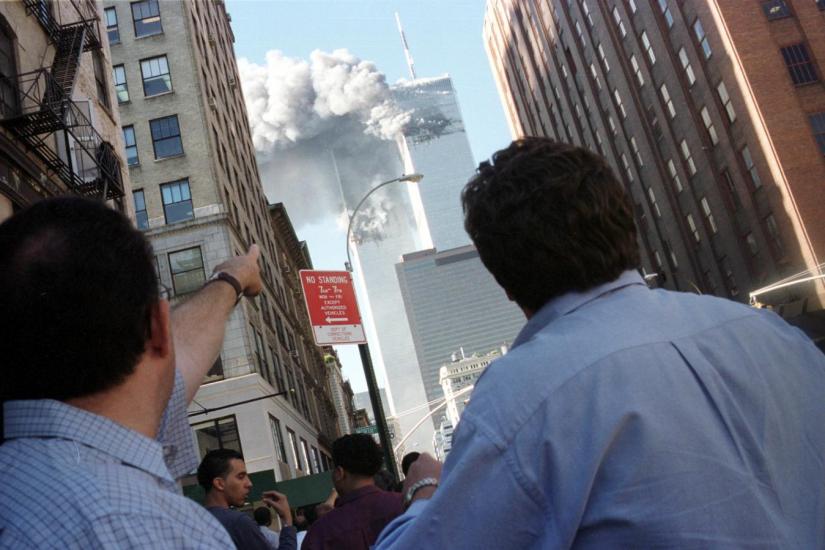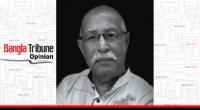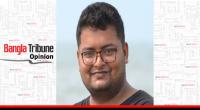 Yet again the month of September comes and we are reminded of the terrorist attack on the USA that occurred eighteen years back. As we look back at the Sept 11, 2001, brutal attack and subsequent media coverage, we recall that the incident was widely discussed in Bangladesh media as well. Initially, the deadly attack came in the media as a shock to humanity for the enormous loss of lives and property it had caused. Subsequently, linkages to Muslim terrorists like Osama Bin Laden provided the opportunity for analysts for a more comprehensive review and portrayal of the incident. In this write-up, I have attempted to analyze how the news media, especially THE newspapers in Bangladesh covered this complex and sensitive issue.
Yet again the month of September comes and we are reminded of the terrorist attack on the USA that occurred eighteen years back. As we look back at the Sept 11, 2001, brutal attack and subsequent media coverage, we recall that the incident was widely discussed in Bangladesh media as well. Initially, the deadly attack came in the media as a shock to humanity for the enormous loss of lives and property it had caused. Subsequently, linkages to Muslim terrorists like Osama Bin Laden provided the opportunity for analysts for a more comprehensive review and portrayal of the incident. In this write-up, I have attempted to analyze how the news media, especially THE newspapers in Bangladesh covered this complex and sensitive issue.
During this period, there was no political government in power in Bangladesh and the administration was run by the Caretaker government. The country was on the verge of the general elections, scheduled to be held on Oct 1, 2001. While the Bangladesh government unequivocally condemned the tragedy, common people, especially Muslims, were curious to know more about the matter and newspapers tried to satisfy the requirements of their readers.
In this article, I have tried to find out how the newspapers responded to the inner conflicts of “responsibility and humanism” versus “popular demand” in their portrayal of the event. As in every country, in Bangladesh politics and media are also intertwined. Mass media, particularly newspapers at that time were not free from ideological bias. There were newspapers ideologically ranging from the extreme right to moderate left. With regard to the Sept 11 event, newspapers in their editorials and news treatment vehemently condemned the attack. At the same time, they were forced to highlight the issue as much as possible to provide readers with every detail of Laden and Taliban linkages. Was that because of fear of losing the circulation war with one or two more Islamist newspapers? To what extent the popular demand of common Muslims and the journalists’ historical antagonism towards the West, converged? Were the news media careful enough to cover the issue and follow the official line? To what extent the business and political nexus of the newspapers contributed to the coverage of the event? These are some of the questions this article attempts to address.
Bangladesh’s mainstream media, particularly its press are secular in nature and the media always remain vigilant against the infusion of religion in politics. This is because of Bangladeshi intellectuals’ historic antagonism towards Pakistani occupation and the torture and repression seen in the name of Islam. Moreover, a section of journalists was also influenced by the communist ideology of the ’70s and early ’80s. Bangladesh carries within its womb the diverse contradictions common to all Afro-Asian nations. If we look back at 2001, we find the unmistakable existence of two broad ideological divisions - Bangladeshi nationalism vs. Bengali nationalism, represented by two major political parties. No wonder, newspapers were also divided along these lines.
I studied three newspapers in Bangladesh from 12th to 30th Sept 2001. I picked one left-leaning, one centrist and on right-wing Islamist newspaper for the study. Names of the newspapers are not being disclosed for obvious reasons. The left-leaning newspaper used to support the Communist parties of Bangladesh and favoured their ideology. Between the other two newspapers, one was generally centrist and the other was right-wing Islamist in their approach, positioning and policy reactions.
The left-leaning newspaper was once very famous during the heydays of communism. It used to enjoy moderate coverage and was popular among the Bangladeshi intelligentsia. It condemned such heinous activities, but it did not forget to mention that the Taliban and the Afghanistan crisis were the creation of the USA. They regarded the Taliban as the Frankenstein, which the USA had created for their own geostrategic reasons. USD 5 billion had been pumped into the Afghan War to create fundamentalist bombs like the Taliban. In the op-ed columns, the newspaper mentioned that Islam had become the enemy of the West following the end of the Cold War and the collapse of the Soviet Union. It may be mentioned that the newspaper took an anti-fundamentalist stand for the forthcoming general elections by urging all not to vote anti-liberation rightists, communalists and the ownerS of the black money. It vehemently opposed President Bush’s use of the word crusade. Left political parties reacted strongly against the US proposal of using American warplanes flying over Bangladesh, though both the major parties in Bangladesh gave their consent to use the territory. Such reactions of the communist parties were highlighted in the newspaper.
 The right-wing Islamist newspaper also condemned the massive loss of innocent lives. But it also highlighted the attacks on Muslims, telling the readers that such terrorist activities were the outcome of injustice, systematically committed by the USA. One of the major features of the coverage that the daily was that it questioned the evidence of Laden’s involvement in the strike. It published several news items on how Bangladeshis were being attacked in different places of the USA. It urged the USA to change its policies and not to attack Afghanistan. The newspaper seemed to be more concerned about the Muslim identity and cited the views of Islamic parties who were against the use of Bangladesh territory. It covered processions in different parts of Bangladesh. In regular op-ed columns, the consequences of war and the US-EU divisions over the war were discussed. The newspaper took a strong position against Bush’s remarks like the word crusade and attacked Huntington’s clash of civilization thesis.
The right-wing Islamist newspaper also condemned the massive loss of innocent lives. But it also highlighted the attacks on Muslims, telling the readers that such terrorist activities were the outcome of injustice, systematically committed by the USA. One of the major features of the coverage that the daily was that it questioned the evidence of Laden’s involvement in the strike. It published several news items on how Bangladeshis were being attacked in different places of the USA. It urged the USA to change its policies and not to attack Afghanistan. The newspaper seemed to be more concerned about the Muslim identity and cited the views of Islamic parties who were against the use of Bangladesh territory. It covered processions in different parts of Bangladesh. In regular op-ed columns, the consequences of war and the US-EU divisions over the war were discussed. The newspaper took a strong position against Bush’s remarks like the word crusade and attacked Huntington’s clash of civilization thesis.
The centrist daily attempted to give moderate and balanced coverage. In its very first page, it condemned the incident strongly. It described the incident as a wake-up call for the USA but also reminded readers that revenge was not justice. In one editorial it said that they hoped that the US would brace itself for a sustained fight against terrorism in concert with the rest of the world rather than settle for a quick fix which could lead to a no-win situation. Political and economic implications of the war were thoroughly discussed in this newspaper. On the whole, the coverage was balanced and obviously there was an attempt for dispassionate and objective analysis.
If we summarize, we see that a sizeable segment of the public opinion, as reflected in the media, was at variance with the foreign policy initiatives of the caretaker government. The dilemma of the government was not properly reflected in the newspapers; on the contrary, the newspapers, more or less, followed the popular line.
Simultaneously it seemed that public opinion was not favourable towards the Taliban from the very beginning, but Osama or Taliban became the symbol of defiance against a superpower and it was reflected in the newspapers. The Islamist newspaper tried to associate Saddam and the Taliban with Islam and as the newspaper tried to depict the images of the traditional fight between Islam and the Christianity, other newspapers also felt such pressures to keep them strong in the circulation market.
It was praiseworthy that the newspapers tried to exercise sufficient analytical skills, but used only their own theoretical frameworks to analyze, reflect and create images of the event. To some extent, the USA came under attack from all the viewpoints - leftist, centrist and rightist. Despite the fact that they tried to see events through their different perspectives, to a certain degree, their viewpoints converged in criticizing the USA. But they were all critical about the heinous incident and did not try to dissociate themselves from the USA, which was the sole superpower and therefore they were very cautious in making any undiplomatic judgment.
The writer is the chief executive of the Bangladesh Center for Research and Communication (BCRC). He can be reached at [email protected]


